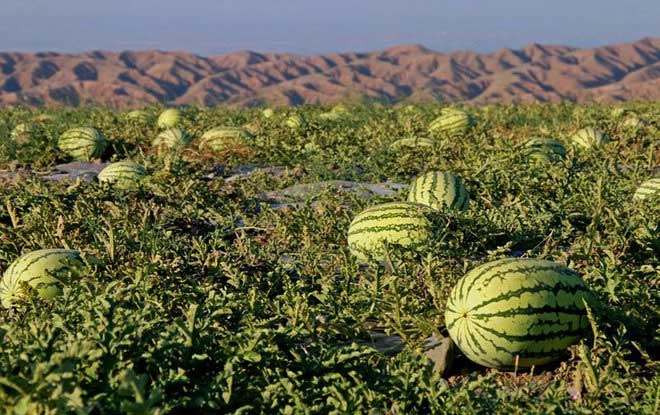Have you ever seen a watermelon growing in a crack in the rocks? Since March 2021, in Hong Tu Bao District, western China, a ban was announced on the cultivation of Selen watermelons.
In fact, after this announcement, it garnered widespread attention in society. Some netizens even expressed their discontent, noting that local farmers could earn 2 billion yuan per year (equivalent to 7 trillion Vietnamese dong) from cultivating Selen watermelons.
1. What is Selen Watermelon?
This is a high-value watermelon variety grown in desert regions. It is often referred to as “gold” in the desert. Notably, it contains selenium, which has antioxidant properties and helps prevent free radical damage, thus reducing cancer risk.

This watermelon is large and sweet, with each fruit weighing about 9kg.
Selen watermelon is a popular fruit in Northwest China, known for its large and sweet fruits. Each watermelon typically weighs around 9kg.
The most important aspect is that this type of watermelon stays fresh for a long time. They can be stored for at least 30 to 50 days without spoiling. This is very convenient for transporting watermelons to other regions or for export.
This type of watermelon is planted around April and May each year. After about 3 to 4 months, farmers can harvest the fruits.
The Northwest region of China is the most suitable area for growing Selen watermelons because it is far from cities, has a relatively clean environment, and is less affected by industrial pollution. Additionally, due to the high terrain, there are relatively few birds and pests, which means farmers do not need to use pesticides.
Because of these factors, the consumption of this watermelon is very good, and farmers reap significant profits from cultivating this fruit.
2. Why is it said that this watermelon grows in cracks?
The Northwest region of China is a land that does not meet the requirements for agricultural cultivation. The soil here is sandy and lacks sufficient water supply, making it difficult to grow crops.
But how come the watermelons grown here are so large and sweet?
In the past, watermelons were often seen in desert regions like North Africa and India. Although these watermelons were not edible, there existed a hypothesis that watermelons could thrive in desert conditions.

Selen watermelon has a high yield. (Image: Toutiao).
Thus, farmers in China began to explore methods for cultivating watermelons in the desert. The cultivation method involves covering the base of the plants with a thick layer of gravel to create a surface cover.
This way, direct sunlight on the soil is minimized, reducing water evaporation from the ground.
Therefore, this cultivation method is known as “sand pressing cultivation.” Watermelons grown this way tend to be larger and sweeter, with bright red and juicy flesh, even sweeter than Kirin watermelons (a famous variety from Japan) or other watermelons available in the market.
In this region, the temperature difference between day and night is significant, making the watermelons grown here generally sweeter. The most famous watermelon cultivation area in China is the Ningxia region.
3. Huge profits attracting farmers
In early 2004, the total area of watermelon cultivation across China was only about 100,000 acres. However, with the rise of Selen watermelon’s popularity, within less than two years, the area planted increased to 720,000 acres.
Later, with the strong development of e-commerce and improved transportation, more and more channels for selling Selen watermelons emerged, broadening its sales range.
Although there is only one watermelon harvest per year, the time from sowing seeds to harvesting is only three to four months, with production reaching millions of tons, sometimes even more.
According to data from 2019, the production of Selen watermelon in Ningxia reached 1.8 million tons, with sales exceeding 2 billion yuan.
After that, Ningxia was recognized as the “hometown of Selen watermelon cultivation,” attracting many visitors to observe this unique cultivation method.

This plant is suitable for desert cultivation. (Image: Toutiao).
4. A billion-dollar crop but limited cultivation
The method of cultivating Selen watermelon involves covering the base with a 10-15 cm thick layer of gravel to create a soil cover. This type of soil cover is the reason why watermelon cultivation cannot be expanded.
The arid region of central Ningxia suffers from drought, low rainfall, and a fragile ecosystem. Sand-pressing cultivation is an unsustainable production method. The agricultural productivity has severely impacted the ecological environment and sustainable agricultural development.
Most of the gravel used for soil covering contains ash and calcium, and prolonged use of gravel will lead to the loss of the original soil’s fertility.
Continuous sand-pressing cultivation over the years results in mixed sandy soil, diminishing the plowed layer, and the organic matter in the soil decreases year by year. Most sand-pressing methods rely on supplementary groundwater irrigation, using wells to extract water, leading to declining groundwater levels and thickening dry soil. Over time, using brackish water for irrigation causes soil salinization, deteriorating soil structure and resulting in soil desertification and rock desertification.
This leads to the severe degradation of vegetation. Most of the sand-pressing land has become desertified grasslands, and human intervention in sand-pressed land has disrupted the ecological balance, resulting in vegetative destruction and ecosystem decline. Moreover, it has caused severe soil erosion. Over the years, rivers, hillsides, valleys, and grasslands have been recklessly dug up due to sand-pressing cultivation, causing localized soil erosion.
Ultimately, people began to establish standardized watermelon fields. They adopted water-saving cultivation methods like plastic mulching and drip irrigation. At the same time, they also had to plant a large number of honeysuckle plants to restore the locally devastated ecological environment.




















































